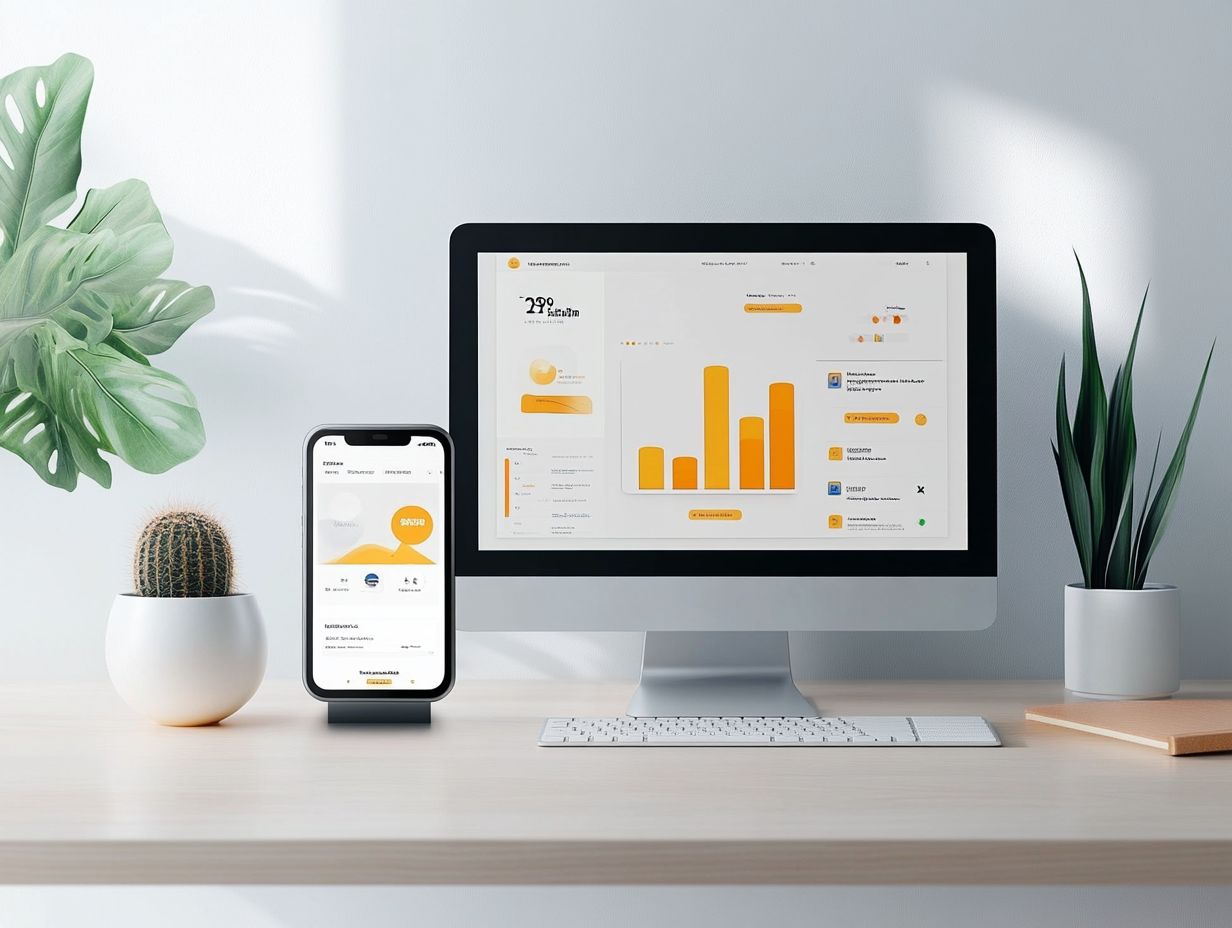The Impact of Mobile Responsiveness on Sales
In today s digital landscape, mobile responsiveness has become a pivotal factor in determining your business’s success. With an ever-growing number of consumers browsing and shopping from their smartphones, understanding mobile optimization is essential.
This article explores what mobile responsiveness means, its effect on user experience, and how it influences your sales. You’ll discover key elements for crafting a responsive website, best practices to adopt, and metrics to gauge your success.
Discover how adopting a mobile-friendly approach can transform your sales strategy and skyrocket customer satisfaction!
Contents
- Key Takeaways:
- The Importance of Mobile Responsiveness for Sales
- How Mobile Responsiveness Affects User Experience
- Optimizing for Mobile Responsiveness
- Measuring the Impact of Mobile Responsiveness on Sales
- Frequently Asked Questions
- What is the impact of mobile responsiveness on sales?
- Why is mobile responsiveness important for sales?
- How does mobile responsiveness affect user experience?
- Does mobile responsiveness impact search engine rankings?
- What are some key features of a mobile responsive website?
- How can a business improve its mobile responsiveness to increase sales?
Key Takeaways:

- Mobile responsiveness is crucial for increasing sales in today’s digital age.
- Optimizing for mobile improves user experience and boosts sales through better navigation, faster page load speed, and attractive design.
- Tracking metrics and implementing best practices for mobile responsiveness can effectively measure and improve its impact on sales.
What is Mobile Responsiveness?
Mobile responsiveness is your website s ticket to thriving in a world where users predominantly access content through smartphones and tablets. It s all about adapting seamlessly to various devices to ensure an optimal user experience.
Think of flexible layouts that enhance accessibility for everyone, delivering a consistent browsing experience regardless of screen size or resolution. With mobile marketing on the rise, understanding mobile responsiveness is crucial for businesses aiming to elevate their online presence.
A key aspect of mobile responsiveness involves using fluid grids and responsive images that scale perfectly to fit different screens. This strategy not only aligns with content consumption trends but is also vital for services like mobile banking, where user satisfaction relies on ease of use and quick accessibility.
As search engines prioritize mobile websites, a responsive design significantly affects your website s visibility in search results. In a time when users crave instant gratification, a mobile-friendly design can enhance engagement, drive traffic, and boost conversion rates.
The Importance of Mobile Responsiveness for Sales
In today s fast-paced digital landscape, mobile responsiveness is essential for achieving sales success, particularly for businesses in the e-commerce sector.
A flexible layout dramatically enhances your conversion rates and elevates customer engagement. As local customers increasingly rely on their smartphones for online shopping, a mobile-responsive website becomes a competitive advantage that can significantly boost your e-commerce sales.
Statistics and Trends
Recent statistics indicate that mobile responsiveness has shifted from a luxury to an essential requirement for effective online marketing. The shift towards mobile-first interactions has accelerated, resulting in a notable increase in website traffic from mobile devices since the COVID-19 pandemic.
Data shows that a mobile-responsive design enhances user engagement and significantly reduces bounce rates, underscoring its importance in today s competitive landscape.
With most consumers browsing websites on their smartphones, the consequences of neglecting mobile optimization are glaring. Reports reveal that nearly 50% of users will abandon a site that takes more than three seconds to load on their mobile device, emphasizing the need for fast-loading, visually appealing layouts.
Don t miss out companies that prioritize mobile-friendly designs are already reaping substantial rewards, experiencing significant boosts in conversion rates and customer loyalty. As online shopping increasingly shifts towards mobile platforms, adapting to these trends is crucial for marketers seeking to effectively capture and retain their audience.
How Mobile Responsiveness Affects User Experience
Mobile responsiveness has a big effect on your users’ experience. It ensures that your website is effortlessly navigable and interactive, no matter what device they re using.
A well-optimized mobile site enhances usability by providing intuitive navigation, swift page load speeds, and visually appealing design elements tailored for mobile users. This enhancement not only elevates customer satisfaction but can also dramatically boost your conversion rates, making a huge difference in your success online!

Effective navigation and usability are essential elements of mobile responsiveness. They allow you to find information on your mobile device while enjoying a seamless user experience.
A mobile-friendly website should feature well-defined menus, touch-friendly buttons, and logical flows that cater specifically to your behavior as a mobile user. This enhances overall accessibility for everyone.
When intuitive navigation is prioritized, customer engagement skyrockets. You can complete tasks quickly and efficiently. Take mobile banking, for example; you expect to conduct transactions smoothly without unnecessary roadblocks.
Incorporating features like prominent search bars, streamlined checkout processes, and visually appealing layouts can significantly elevate your experience.
Conducting usability tests with real users can reveal pain points and highlight areas for improvement. This ensures that the design meets your expectations and boosts overall satisfaction.
Page Load Speed
Page load speed is a vital element of mobile responsiveness. It profoundly impacts user experience and directly influences your website traffic and conversion rates.
When mobile pages load slowly, you risk driving users away, especially those who expect immediate access to content on their devices. To improve load times, you should optimize images, employ efficient coding practices, and consider using services that help deliver website content faster.
Prioritizing fast-loading pages enhances your SEO performance and elevates customer satisfaction. Users are far more inclined to engage with and return to sites that operate smoothly.
Incorporating caching techniques and minimizing the use of heavy scripts can further streamline your loading process. This creates a seamless experience that encourages visitors to return time and again.
Design and Layout
The design and layout of your website are crucial for achieving effective mobile responsiveness. This allows for flexible designs that adapt to various screen sizes and orientations.
A well-structured layout enhances user experience by presenting content in a visually appealing way that’s easy to navigate on mobile devices. This adaptability is essential, especially as remote work becomes increasingly common.
Users frequently access websites while on the move, making it imperative that your designs look stunning and function intuitively. By incorporating principles like grid systems (a framework that helps arrange content neatly), fluid images, and touch-friendly elements, you can significantly elevate user engagement.
This is particularly critical in the realm of mobile advertising, where a clunky layout can drive potential customers away. By prioritizing accessibility and responsiveness in your design, you can ensure that your digital presence effectively reaches and resonates with a diverse audience.
This ultimately enhances overall satisfaction and boosts conversion rates.
Optimizing for Mobile Responsiveness
Optimizing for mobile responsiveness requires you to implement essential elements that elevate the usability and effectiveness of your website across a range of mobile devices.
By concentrating on best practices in design, layout, and navigation, you can markedly enhance user engagement. This ensures that your site not only meets but exceeds the expectations of mobile users.
Call to Action: Start implementing mobile responsiveness strategies on your website today to enhance user experience and boost your success online!
Key Elements for a Responsive Website
Key elements for a responsive website include flexible layouts, media queries (which allow you to adjust styles based on different screen sizes), and scalable images that adapt to mobile devices. This ensures users enjoy a visually coherent and functional experience.
Incorporating fluid grids allows for proportional resizing of content. When you combine this with well-placed media queries, you can make precise adjustments to elements based on the device in use. This ensures each visitor enjoys seamless content consumption.
Implementing touch-friendly navigation elements can significantly enhance usability for mobile marketing efforts, drawing in more engagement. Prioritizing loading speed is crucial. A faster website keeps users engaged and boosts your conversion rates.
By focusing on these strategies, you can create sites that effectively cater to diverse audiences and enhance overall user satisfaction.
Best Practices for Mobile Responsiveness

Implementing best practices for mobile responsiveness is essential for enhancing usability and delivering an exceptional experience on mobile devices. You should prioritize mobile-first design, optimize images, and minimize redirects to create a seamless journey for your users.
By adopting these strategies, you not only increase accessibility but also significantly boost engagement rates. Users are far more likely to remain on a site that is easy to navigate on their phones. Search engines like Google recognize this and prioritize mobile-friendly sites in their rankings, making these practices essential for effective SEO performance.
Incorporating responsive design principles such as flexible grid layouts and fluid images ensures that your content scales appropriately across various screen sizes. Regularly testing and updating your website for mobile compatibility signals a commitment to user satisfaction, ultimately fostering trust and loyalty among your visitors.
Measuring the Impact of Mobile Responsiveness on Sales
Measuring the impact of mobile responsiveness on sales requires a thoughtful analysis of various metrics that reveal user behavior, engagement, and conversion rates. This approach equips you with actionable insights to enhance your strategies.
Understanding these metrics is vital for assessing the effectiveness of your mobile marketing initiatives and their influence on e-commerce sales. This allows you to make informed decisions that drive growth.
Metrics to Track
Tracking the right metrics is crucial for evaluating how well your mobile responsiveness is driving sales and enhancing the overall user experience. Focus on key metrics such as conversion rates, average session duration, and bounce rates; these provide valuable insights into your website traffic and user engagement.
A thorough analysis of these metrics can reveal how effectively your site retains visitors and converts them into customers. For example, if you notice low conversion rates, it may indicate navigation issues on mobile devices. Conversely, high bounce rates could suggest that your content isn t engaging enough for users on the move.
Understanding SEO performance metrics like mobile page load times and search rankings highlights areas that need improvement. By making incremental adjustments based on these data points, you can foster better customer engagement, ultimately leading to higher sales. This reinforces the necessity for ongoing evaluation in your digital strategy.
Start optimizing your website today for a better mobile experience!
Case Studies and Examples
Case studies show the tangible benefits of mobile responsiveness. These real-world examples illustrate the importance of mobile design today.
For instance, a leading e-commerce platform streamlined its mobile site by implementing an easy checkout and optimizing loading times. This savvy move resulted in a remarkable 30% increase in conversion rates.
A local restaurant chain embraced responsive design to improve mobile reservations, resulting in a significant uptick in customer engagement and customer satisfaction ratings.
These examples emphasize the value of a mobile-first approach and offer valuable insights into best practices. By utilizing user testing and mobile analytics, you can maximize the benefits of responsive design.
Frequently Asked Questions
What is the impact of mobile responsiveness on sales?
Mobile responsiveness directly affects how much you sell online. If your website isn’t mobile-friendly, you could be losing out on sales.

Why is mobile responsiveness important for sales?
Mobile responsiveness is crucial for sales since most internet traffic now comes from mobile devices. Understanding the importance of a responsive design for sales can help avoid a poor user experience and lost sales opportunities.
How does mobile responsiveness affect user experience?
Mobile responsiveness makes browsing enjoyable and frustration-free. A site that isn t mobile-optimized can frustrate users.
Does mobile responsiveness impact search engine rankings?
Yes, mobile responsiveness can impact search engine rankings. Google considers it a key factor in its ranking algorithm, and non-optimized sites may suffer penalties in search results.
What are some key features of a mobile responsive website?
A mobile responsive website should have a clean design, easy navigation, fast loading speed, and easily clickable buttons. It should also adapt flexibly to different screen sizes and resolutions.
How can a business improve its mobile responsiveness to increase sales?
A business can enhance its mobile responsiveness by using responsive website design, optimizing images and videos for mobile, and testing the site on various devices. Regular updates and maintenance are also important to keep the website mobile-friendly.
Don’t miss out on the advantages of mobile responsiveness! Evaluate your site today to ensure it’s optimized for mobile users.






